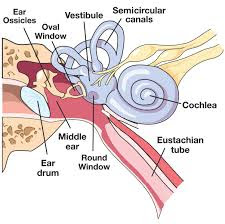How human's ears help to balance the human body?
How human's ears help to balance the human body?
The ear is one of the sensory organs that help us to hear. An interesting point to note is that the ear not only helps in hearing but also helps us to maintain the balance and equilibrium of our body. Without the ear, we would not be able to balance our body with respect to the gravitational pull of the earth.
To understand how the ear helps us to balance our body, we need to know about the structure of the ear.
Structure of the Ear
The ear is made up of three different parts -
- outer ear
- middle ear
- inner ear
The inner ear is the part that helps us to balance our body. The inner ear is involved in both the functions of hearing and balancing.
Structure of the Inner Ear
The inner ear is enclosed within the temporal bone of the skull.
The inner ear is made up of two small parts -
- cochlea
- semicircular canals
The cochlea is a coiled structure that resembles the shell of the snail.
The cochlea and the semicircular canals are connected by a structure called the vestibule.
The vestibule has two smaller structures called the saccule and the utricle.
How does the inner ear help to maintain balance and equilibrium?
Two structures of the inner ear help to maintain balance and equilibrium -
- the three semicircular canals that are interconnected and positioned at right angles to each other just like a gyroscope.
- the vestibule (has the saccule and utricle) that connects the semicircular canals to the cochlea
The semicircular canals and the vestibule of the inner ear together help to maintain the balance and equilibrium of the body.
Dynamic equilibrium lets us know the direction in which our head is moves in three-dimensional space and also gives us information about rotation. The information about the dynamic equilibrium is detected in the semicircular canals which are attached to the vestibule.
The semicircular canals are filled with a fluid called the endolymph. Each one of the semicircular canals has an enlarged cup-like structure called the cupula. The cupulahas thin hair like cells.
Whenever the head moves, the fluid in the canals move. When the fluid in the canals moves, the hair cells move in the direction of the fluid.
The hair cells transmit the information about the direction of bending to the sensory neurons of the vestibulocochlear nerve (vestibular branch) which then sends the information about the direction of the movement to the cerebellum.
The horizontally positioned utricle and the vertically positioned saccule are the two sensory chambers present in the vestibule of the inner ear. The utricle and saccule are responsible to help maintain the static equilibrium of the body.
Static equilibrium helps us to detect the positioning of our head relative to gravity, that is it helps us realize which way the head is tilted.
When the head moves the otoliths are pulled in the direction of gravity or opposite to the direction of the movement. The movement pulls the gelatinous membrane which in turn bends the hairs of the hair cells. The hair cells transmit the information about the position to the sensory neurons and these sensory neurons send the signals through the cranial nerve VIII of the vestibular branch to the cerebellum.
The signals that are detected by the hair cells of both the semicircular canals and the vestibule are converted into nerve impulses and sent to the brain through the vestibular nerve. The brain also receives signals from the visual and skeletal system of the body.
The brain coordinates all three signals from the inner ear, visual system and skeletal system to maintain balance and equilibrium of the body.
Labels: human body




0 Comments:
Post a Comment
Subscribe to Post Comments [Atom]
<< Home